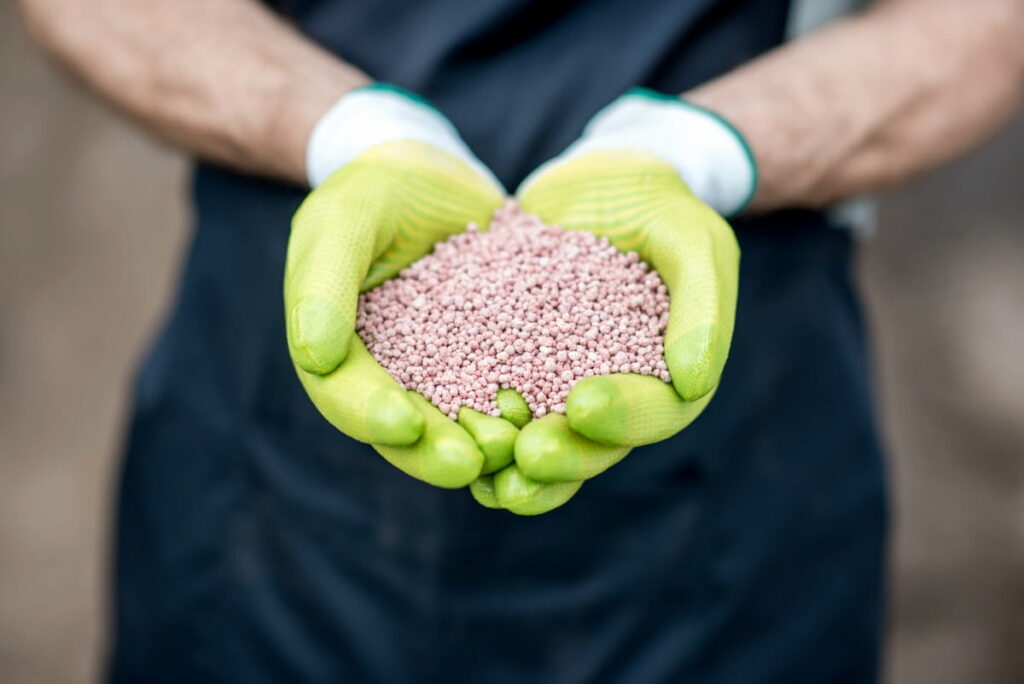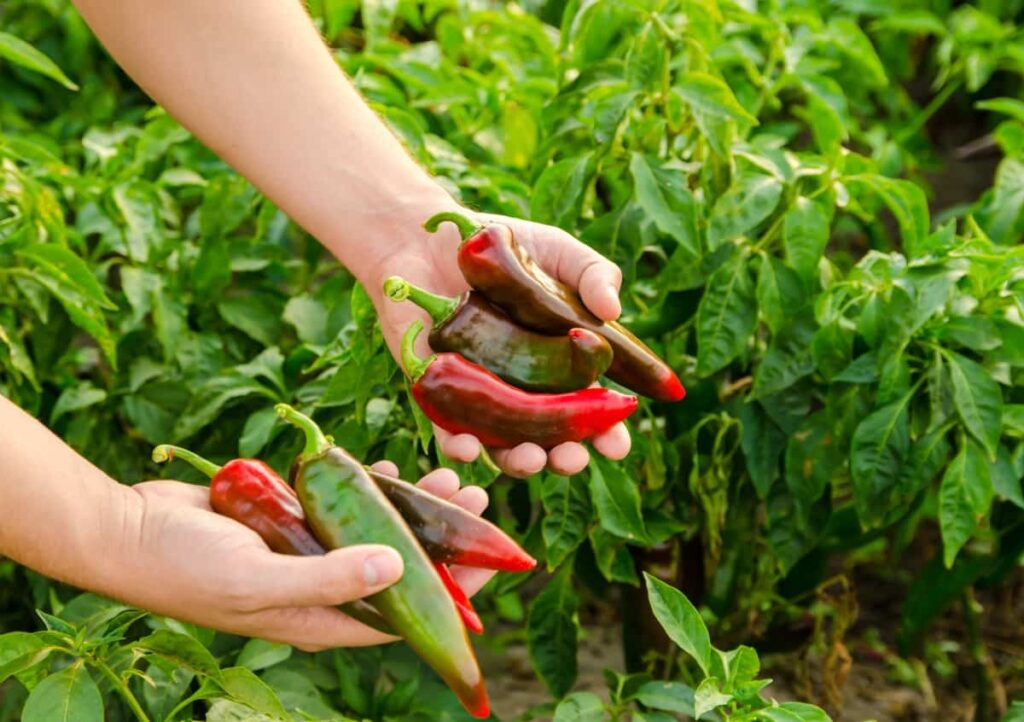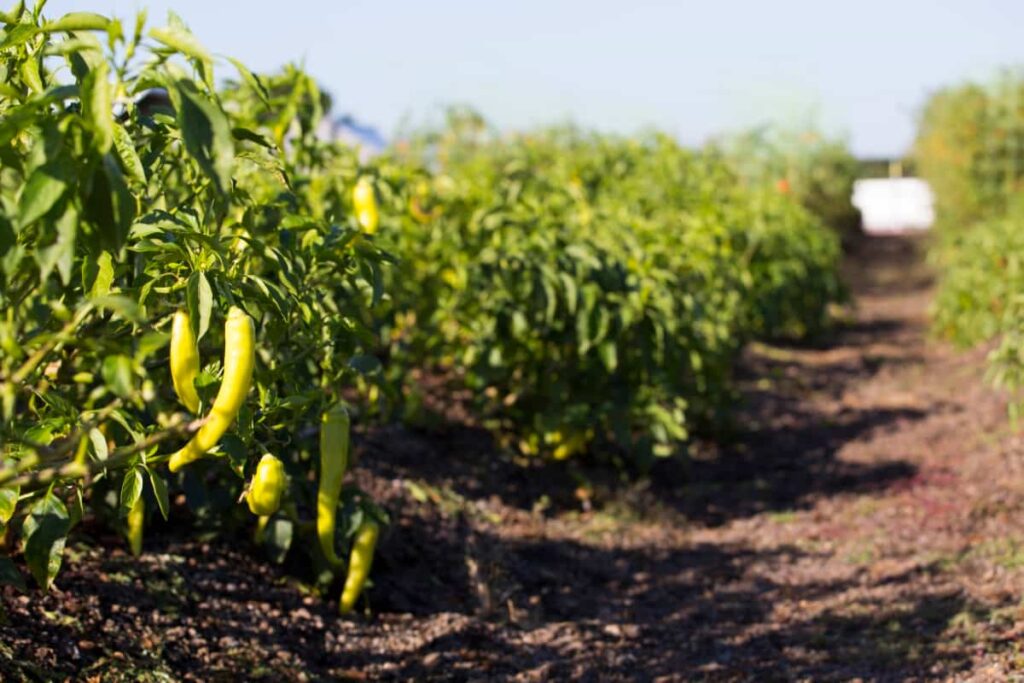Welcome to the Chili Pepper Fertilization Guide! Growing vibrant and flavorful chilies requires a tailored approach. Explore our Fertilizer Schedule, Soil Preparation tips, and Organic fertilizer techniques to optimize each growth stage for bountiful chili harvests.

Chilli Pepper Growth Fertilizer
Introduction to Chilli Pepper Fertilization
Chilli peppers require proper fertilization for growth and high yields. Fertilization adds nutrients to soil or plants, with different types including organic, inorganic, liquid, granular, slow-release, and foliar. Each type has its advantages and disadvantages, depending on soil conditions and farmer preference.
Importance of Fertilization in Chilli Pepper Cultivation
Chilli peppers require proper fertilization to grow well and yield high yields. Different types of fertilizers, including organic, inorganic, liquid, granular, slow-release, and foliar, have their advantages and disadvantages depending on soil condition, crop stage, and farmer preference. This article provides basic concepts and tips for the effective fertilization of chili peppers.
Understanding Chilli Pepper Nutrient Needs
Chilli peppers, a spicy fruit, are rich in vitamins, minerals, and antioxidants, particularly vitamin C. They require high-quality fertilizer with nitrogen, phosphorus, and potassium for green growth, root development, and disease resistance. Chilli peppers also require adequate watering, sunlight, and soil pH for optimal health.
Soil Assessment and Preparation
Soil assessment and preparation are important steps for successful chili pepper cultivation. Chilli peppers prefer well-drained, fertile, and acidic soils. Before planting, the soil should be tested for nutrient levels, salinity, and possible diseases or pests. Based on the test results, the soil may need to be amended with organic matter, lime, or fertilizers. The soil should also be tilled and leveled to create a smooth and uniform surface for planting.
Conducting Soil Tests for Nutrient Levels
Soil tests are crucial for chili pepper cultivation, determining pH, organic matter, and nutrient availability. Chili prefers slightly acidic soil with a pH range of 6.0 to 6.8, which affects nutrient uptake. Tests can reveal deficiencies or excesses that may affect pepper growth and yield. Soil amendments like lime, sulfur, compost, or fertilizers can be applied based on test results and should be conducted several months before planting.
Preparing Soil for Chilli Planting
Chilli plants require well-drained, organically rich soil with a pH between 6 and 7. To prepare, test the soil pH and adjust with lime or sulfur. Loosen the soil to 12 inches, mix compost or aged manure, add controlled-release fertilizer or potassium-rich organic mulch, and clear weeds, rocks, and debris before planting chili seeds or seedlings.
Fertilization Schedule Overview
Chilli plants require regular fertilization to produce healthy and abundant fruits. The fertilization schedule depends on the growth stage of the plants, the soil type, and the environmental conditions. Here is a general overview of how to fertilize chili plants.
Key Stages of Chilli Pepper Growth
- Seedling Stage: Use a balanced fertilizer (10-10-10) once a week and Avoid high-nitrogen fertilizers to prevent excessive leaf growth and delay flowering.
- Flowering Stage: Switch to fertilizer with higher phosphorus and potassium content (5-10-10) every two weeks.
- Fruiting Stage: Continue using the same fertilizer, but reduce the frequency to once a month and Use liquid fertilizer every week at half-strength.
- Harvesting Stage: Stop fertilizing once fruits are harvested to use up nutrients and improve flavor.
Timing and Frequency of Fertilizer Applications
Transplanting of chili plants requires a balanced fertilizer, such as NPK 15-15-15, to promote growth. A high phosphorus and potassium fertilizer, like NPK 10-20-20, is applied two weeks after transplanting. In the flowering stage, potassium and calcium are needed for flower formation and fruit set. A high potassium and calcium fertilizer is applied when the first fruits are formed and repeated every two weeks until harvest.
Seedling Stage Fertilization
Transplanting of chili plants requires a balanced fertilizer, such as NPK 15-15-15, to promote growth. A high phosphorus and potassium fertilizer, like NPK 10-20-20, is applied two weeks after transplanting. In the flowering stage, potassium and calcium are needed for flower formation and fruit set. A high potassium and calcium fertilizer is applied when the first fruits are formed and repeated every two weeks until harvest.
Nutrients Important for Seedlings
A balanced mix of nutrients is crucial for healthy growth and fruit production in chili plants. Primary nutrients include nitrogen, phosphorus, and potassium, while secondary nutrients include calcium, magnesium, sulfur, iron, manganese, and zinc. A suitable growing medium and regular feeding schedule are essential. Seaweed-based fertilizer or general-purpose plant food can be applied at a quarter strength once a week, gradually increasing strength as seedlings grow.
Recommended Fertilizer Types and Amounts
Chilli cultivation requires proper fertilization, including farmyard manure (FYM), 50 kg of urea, 100 kg of single super phosphate (SSP), and 34 kg of muriate of potash (MOP). For rainfed cultivation, 8 tonnes of FYM, 50 kg of SSP, and 34 kg of MOP are recommended, while for irrigated cultivation, 167 kg of urea, 150 kg of SSP, and 72 kg of MOP are recommended.
In case you missed it: Chilli Pepper Cultivation Cost Per Acre in India: Exploring State-wise Average Production Cost

Vegetative Growth Stage Fertilization
Chilli cultivation requires Vegetative Growth Stage Fertilization to ensure healthy, productive plants. A balanced supply of N, P, and K is essential for growth. Common fertilizers include NPK (19:19:19) or organic fertilizers like Marvelz-G, compost, or manure. Applying these fertilizers before sowing or transplanting can significantly improve crop yield and quality.
Enhancing Leaf and Stem Growth
The fruiting process in chili plants necessitates a balance of nutrients, sunlight, and water for optimal growth. Organic fertilizers, regular watering, and pruning prevent root rot and fungal diseases. Sunlight, essential for photosynthesis and chlorophyll production, converts light energy into chemical energy.
Balancing Nitrogen, Phosphorus, and Potassium
Chilli plants benefit from a balanced fertilizer schedule, including weekly application of a balanced NPK fertilizer (600 mg N, 120 mg P, 80 mg K per plant) during vegetative stages. Two weeks before flowering, a high-phosphorus fertilizer is recommended. Organic options like compost and manure enhance soil quality, water retention, and microbial activity, while proper watering and micronutrients are crucial for plant health.
Flowering and Fruit Set Fertilization
NPK fertilizer is crucial for chili plants to produce hot and spicy fruits. During flowering and fruit set, high-potassium fertilizer is recommended to promote strong flower development, fruit set, and shelf life. The recommended dose is 25-30 kg per hectare, applied in two doses near the root zone and watered well after fertilization to prevent salt accumulation in the soil.
Nutrients for Flowering and Early Fruit Development
Chilli plants require a balanced diet of nitrogen, phosphorus, and potassium, often applied as NPK fertilizer. Potassium is crucial for strong flower development, fruit set, and fruit quality. A high-potassium fertilizer, such as 13-0-45 or 0-0-50, is recommended for chili plants two weeks before harvest to boost fruit production and prevent fruit drop.
Adjusting Fertilizer Ratios for Fruit Production
Chilli plants benefit from a balanced fertilizer schedule. Use 12-0-0 at planting, 10-10-10 during vegetative growth, 8-16-16 during flowering/fruiting, and 0-0-24 post-harvest. Adjust ratios based on soil tests, chili variety, and growth stages. Regular monitoring and soil tests ensure optimal nutrient levels, promoting healthy growth and improved fruit production.
Fruit Development and Maturation
Chilli cultivation thrives in warm, humid climates, with optimal fruit development occurring approximately 35 days after pollination. Notably, seed development starts 15 days after anthesis. At full maturity, chili fruits, containing around 70% moisture, undergo a color change from green to red or purple, showcasing the accumulation of capsaicinoids. Effective management practices are vital for maximizing the quality and yield, considering factors like temperature, water, nutrients, pests, and diseases.
Sustaining Nutrient Supply During Fruit Growth
For optimal chili cultivation, maintaining a balanced NPK supply, especially during flowering and fruiting, is crucial. The recommended NPK dose is 48:24:16 kg/acre, but soil testing is advised for accurate application. Use high-nitrogen fertilizer during flowering and switch to high-potassium fertilizer two weeks before harvest to enhance fruit development. Incorporating organic manures and biofertilizers further improves soil fertility, reducing reliance on chemical fertilizers and promoting sustainable yields.
Micronutrient Requirements for Quality Fruit
Chilli plants are nutrient-intensive, requiring micronutrients like zinc, boron, iron, copper, manganese, and molybdenum for optimal growth. Deficiencies lead to issues like chlorosis and poor fruit quality. Recommended practices include foliar sprays of zinc sulfate, borax, iron chelate, copper sulfate, and manganese sulfate at specified concentrations to address deficiencies and enhance plant health, yield, and quality. Molybdenum deficiency can be corrected with sodium molybdate spray.
Organic Fertilization Options
Organic fertilization in Chilli cultivation, such as compost and manure, enhances soil health and water retention. Neem cake serves as a natural pest deterrent, while biofertilizers containing living microorganisms improve nutrient availability. Application recommendations include 10-15 tonnes of compost or manure per hectare, 1-2 kg of neem cake per plant, and 5 kg of biofertilizers per hectare, tailored to soil tests and crop needs.
Organic Fertilizers Suitable for Chilli Peppers
Organic fertilizers, which include compost, worm castings, and fish emulsion, provide essential nutrients like nitrogen, phosphorus, and potassium for healthy chili plant growth. These sustainable options enhance soil quality, release nutrients gradually, and promote high-quality fruit yield. Proper application is crucial to avoid over or under-fertilization, ensuring optimal plant health. Integrating Organic Matter into a Fertilization Plan
Integrating Organic Matter into a Fertilization Plan
In chili cultivation, integrating organic matter like compost, manure, neem cake, vermicompost, and oil cakes enhances soil health, reduces chemical inputs, and boosts crop yield and quality. Application methods vary, and the frequency depends on factors like soil type and climate. Combining organic matter with inorganic fertilizers ensures a balanced nutrient supply for optimal crop performance.
Irrigation and Fertilizer Management
Chilli peppers require proper irrigation and fertilization for optimal growth. Drip irrigation is recommended to prevent water stress, and a balanced fertilizer schedule involving organic and inorganic sources is crucial. Nitrogen aids vegetative growth, phosphorus supports root development, potassium enhances fruit quality, and micronutrients prevent deficiencies. Adjust doses based on crop stages for high yields and quality fruits.
Efficient Water Use for Optimal Fertilizer Uptake
Efficient water management is crucial for optimal chili pepper growth. Overwatering and underwatering can impact nutrient uptake. Utilizing irrigation based on crop water needs and soil moisture, employing methods like soil sensors or evapotranspiration models, is vital. Improving soil structure with amendments and implementing drainage systems enhances water retention and prevents issues like waterlogging and salinization.
Avoiding Nutrient Leaching and Runoff
To mitigate nutrient leaching and runoff in chili pepper cultivation, farmers can employ practices like adding organic matter for improved soil structure, using mulch to reduce evaporation and erosion, applying fertilizers judiciously, implementing efficient irrigation systems, and adopting crop rotation or intercropping to enhance soil health and minimize environmental impact.
In case you missed it: Guntur Red Chilli Farming Project Report: Production Cost, Market Analysis, and Cultivation Practices

Monitoring Plant Health and Adjusting Fertilization
To manage nutrient levels in chili peppers, farmers employ soil testing, leaf analysis, and plant growth indicators. Soil testing assesses pH and nutrient levels, while leaf analysis diagnoses deficiencies or excesses. Observing plant growth indicators helps evaluate overall health. Fertilizer recommendations, based on these assessments, guide optimal nutrient supply, considering type, amount, timing, and application method.
Identifying Signs of Nutrient Deficiencies or Excess
Nutrient imbalances can impact chili crop growth. Nitrogen deficiency leads to yellowing and stunted growth, while excess results in lush foliage but scarce fruits. Phosphorus deficiency causes purple spots and slow fruit ripening, whereas excess leads to dark green leaves with a bluish tinge. Potassium deficiency causes leaf browning and small fruits, while excess results in dark green leaves with yellowish tones. These imbalances can also trigger secondary nutrient deficiencies.
Tailoring Fertilization to Plant Needs and Environmental Conditions
Tailoring fertilization involves considering factors like soil type, pH, plant growth stage, and environmental stress. Adjusting nutrient doses based on soil characteristics, optimizing pH for specific nutrients, and aligning fertilizer ratios with growth stages enhance efficiency. Adapting to environmental stress ensures plants receive adequate nutrients despite challenges.
In case you missed it: How to Grow Green Chilli Peppers Faster: Best Tips to Increase Flowering, Fruiting, and Production Yield

Conclusion
As you strive to become an expert at growing chili peppers, keep in mind that knowing and meeting nutritional requirements is essential to success. Our guide provides information on how to regulate fertilizer for the best growth of chili peppers, from seedling to fruit maturity.
- How to Raise Pigs in Your Own Backyard: A Comprehensive Guide
- Budget Friendly Sheep Shed Ideas: Cheap and Low-Cost Tips
- How Much Do Cattle Farmers Make: Revenue Streams in Cattle Farming
- Management Pests and Diseases in Your Cotton Field
- Sheep Farming Business Plan for Beginners
- Aquaponic Farming at Home: A Step-By-Step Guide
- Profitable Village Farming Business Ideas in 2024
- High-Yield Aquaculture: Fast-Growing Fish for Farming
- Effective Fish Pond Construction Techniques for Beginners
